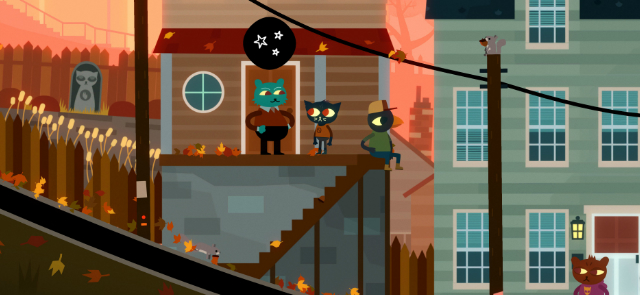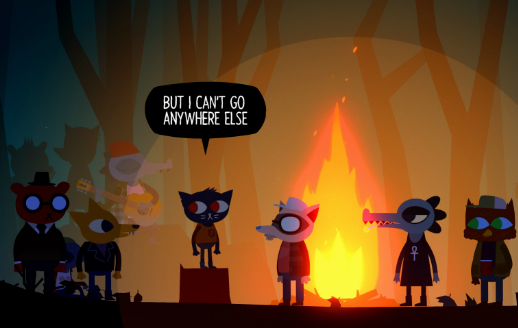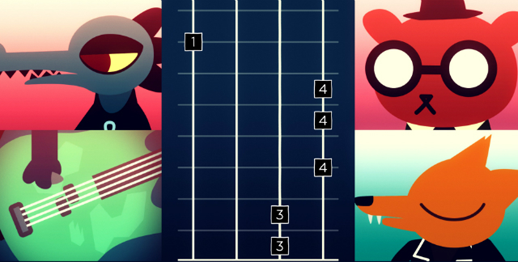 It's a familiar story for many of us old enough to have lived it. Mae Borowski, 20 years old and newly a college dropout, returns to her hometown of the formerly prosperous mining town of Possum Springs in Western Pennsylvania, only to find that the train station is closed and her parents have forgotten to come pick her up.
It's a familiar story for many of us old enough to have lived it. Mae Borowski, 20 years old and newly a college dropout, returns to her hometown of the formerly prosperous mining town of Possum Springs in Western Pennsylvania, only to find that the train station is closed and her parents have forgotten to come pick her up.
From the very first moments, it's clear how troubling it is for Mae to return home; she reunites with her parents and many of her old friends on her first day back, whose mixed reactions set the sharp, emotional tone for the beautifully animated and smartly written adventure game Night in the Woods. While at first Mae enjoys a brief moment of happiness and comfort joining her old friends for band practice and pizza, the discovery of a mysterious severed arm in kicks off a strangely supernatural spiral that drags Mae and her friends to the very depths of Possum Springs, forced to face head-on the most difficult challenges in getting older.
Recently released after an extraordinarily successful Kickstarter run ($209k) and just over three years in development, Night in the Woods comes from Infinite Fall, the powerful teaming of Scott Benson, Bethany Hockenberry, and Alec Holowka. What appears at first glance to be somewhat of a Juno-esque, almost John Hughes-like treatise on youth turns out instead to be a marvelously rich and poignant take on the emotional diaspora of being a young adult. Mae returns to Possum Springs expecting it to be the same as it was before she moved away--and it is, in some superficial way. Her friends are still around, her neighbors, her family. But underneath these reunions is a familiar, crippling sense that everything has changed, that everything around her is fundamentally and permanently different, and it is instead Mae herself who has stayed the same while the world passed her by.
 One part adventure game, one part side-scrolling platformer, Night in the Woods is a game about people, confronting very directly the often-avoided and painfully-existential way that relationships grow apart despite our best efforts to maintain them. Comparable in style to other narrative-driven games of its ilk, such as Oxenfree, sharp, witty dialogue and story take the forefront. Mae wakes each day free to do with her time what she, and the player, chooses. Exploring the town allows her to build relationships with some side characters, such as Selma "Selmers" Forrester and the local pastor, Kate Young, through simple conversation exchanges that build on themselves daily. Other characters, such as Germ and Lori, offer daytime distractions in the form of short vignettes that add richness to town's character and offer moments of introspection for Mae herself, without drawing the day to a close. Hanging out with any of Mae's closest friends, including Gregg and Bea at the outset, and later, Angus, instead moves the game forward to the evening for more poignant narratives that pit Mae directly against her frustrations and the ugly emotional wounds that stand between her and so many of those she used to know intimately as friends.
One part adventure game, one part side-scrolling platformer, Night in the Woods is a game about people, confronting very directly the often-avoided and painfully-existential way that relationships grow apart despite our best efforts to maintain them. Comparable in style to other narrative-driven games of its ilk, such as Oxenfree, sharp, witty dialogue and story take the forefront. Mae wakes each day free to do with her time what she, and the player, chooses. Exploring the town allows her to build relationships with some side characters, such as Selma "Selmers" Forrester and the local pastor, Kate Young, through simple conversation exchanges that build on themselves daily. Other characters, such as Germ and Lori, offer daytime distractions in the form of short vignettes that add richness to town's character and offer moments of introspection for Mae herself, without drawing the day to a close. Hanging out with any of Mae's closest friends, including Gregg and Bea at the outset, and later, Angus, instead moves the game forward to the evening for more poignant narratives that pit Mae directly against her frustrations and the ugly emotional wounds that stand between her and so many of those she used to know intimately as friends.
 Woven so effortlessly through these moments are an impressive number of rather charming and clever minigames that shake up this basic formula. Mae plays the bass in a band with her friends every few days, little blips of nostalgia that take shape as a rhythm game not dissimilar to Guitar Hero in its controls. With certain characters and certain interactions, Mae can shoplift in a very red light, green light sort of motion game, while her dreams, existing as interludes between each day, instead put her platforming skills to the test in order to make it on to morning. More overtly present in Night in the Woods is Demon Tower, a surprisingly punishing and seriously impressive 16-bit dungeon-crawler that lives on Mae's laptop after Angus repairs it and can be accessed anytime Mae is in her bedroom.
Woven so effortlessly through these moments are an impressive number of rather charming and clever minigames that shake up this basic formula. Mae plays the bass in a band with her friends every few days, little blips of nostalgia that take shape as a rhythm game not dissimilar to Guitar Hero in its controls. With certain characters and certain interactions, Mae can shoplift in a very red light, green light sort of motion game, while her dreams, existing as interludes between each day, instead put her platforming skills to the test in order to make it on to morning. More overtly present in Night in the Woods is Demon Tower, a surprisingly punishing and seriously impressive 16-bit dungeon-crawler that lives on Mae's laptop after Angus repairs it and can be accessed anytime Mae is in her bedroom.
What is significant about Night in the Woods is perhaps the very wide net it casts in terms of relatability. It's unlikely that any player will necessarily relate to every storyline, large or small, but there are many that speak to the basic human condition in ways that I often found emotionally powerful and occasionally gut-wrenching in how well they addressed these harsh truths. Of course, not every player will understand what it's like to live in a small town, but many will have confronted poverty, many will understand Mae's parents and the strain they face in having lost their livelihoods. Many may instead resonate with Gregg and his occasionally manic attempts to cling to a nostalgic, childish streak that has outgrown him, while others may find Bea and the suffocating weight of her sacrifices to speak toward the harsh realities of adulthood and life itself that can change even our best laid plans. Some may just remember what it's like to come home after having moved away and find everything at once so similar and so different as to be overcome by a gripping, intense depression that cannot be so easily shaken away or remedied. Moreover, Night in the Woods is also not shy about addressing more intense and adult narratives, such as crises of faith, abuse, mental illness, sexuality, and death which makes it certainly inappropriate for younger audiences but potentially important and nigh unmissable for older ones.
More than once did I find myself brought close to tears
Though certainly the game hits far, far more than it misses, it does suffer from an odd pacing problem toward the latter end which detracts from the long, incredibly thorough and satisfying lead-in with a more rushed and disjointed conclusion. This isn't to say that I disliked the game; indeed, it confronts a number of very important narratives that are often missing in games and perhaps integral to preserving the medium as an effective and fundamental platform for storytelling. More than once did I find myself brought close to tears, especially in the more intimate moments Mae spends with her friends after dark. But it seemed like the game started to lose itself to a slightly different narrative in the final hour or so, not in a large enough way to detract from its overall grandeur, but enough that some players might walk away feeling unsatisfied. Further, Mae and her friends converse in a sort of quintessentially millennial internet speak that, while wry and authentic, may be a quick turn-off to those who dislike such a culture. Night in the Woods also suffers some minor control issues; while the sets are beautiful and well designed, fluid and creative in the way they depict depth in two-dimensions, it can sometimes be frustrating to switch from foreground to background and some brief correction from time to time is a necessity.
Night in the Woods is an unmissable gem
If there is any word that can truly encapsulate Night in the Woods, it is that it is undoubtedly a triumph. It is thoughtful, genuine, and moving and has stuck with me well beyond my initial playthrough of around ten hours. I didn't sink much time into Demon Tower, to my own detriment, but many players who enjoy this wonderful minigame may find it easy to spend twelve or fifteen hours completing their first run of the game. Due to the fact that players must choose which friends of Mae's to spend their time with, it's almost imperative to play the game a second time in order to fully experience the narrative, something I found quite enjoyable as despite my attempts to find everything, I missed quite a few magical moments hidden in the details. For fans of simple side-scrollers and story-driven experiences, or even those who find Mae's story hits very close to home, Night in the Woods is an unmissable gem.
Can also be purchased there as a download without using Steam.
![]() Windows:
Windows:
Get the full version
![]() Mac OS X:
Mac OS X:
Get the full version





Some Tips and secrets:
Parkour
Jumping on the tree outside your house is an easy way to get onto the rooftops to the west.
After the boxes are off the Snack Falcon, you can make a jump from the light pole to the left of it onto a light fixture of the diner, and manage to get onto the roof of said with precise jumps.
After Gregg tells you about his apartment roof door being fixed, you can find a stage by going through the building and heading left over the power line.
Once the Church steps are repaired, the lightpost to the left of said steps can be used to get on the power lines.
This leads to a segment where you can talk to Lori, or go through a window to find a nest of rats.
Side Quests
Crawlspace Boxes
Talk to your Dad each day after examining the boxes repeatedly, until the text repeats, and eventually he'll move the boxes. This allows you to enter the basement.
The combination to the basement safe can be found by reading the bookshelf to the right of the crawlspace entrance repeatedly, until you find a book with the code written in it.
In the Epilogue, the tooth will encourage your Dad to form a union. Library has the details of why this is,
in the newspaper clippings.
Constellations
Every few in-game days, there will be an opportunity to look for stars on top of a roof. Find all of them,
and your teacher will be there to say a few words during the near-end phase. You can get to that roof segment easily by climbing the tree outside your house and following the power line left.
Rats
After the church is open, you can get to the power line to the left of it. One of the windows you can get to above the power lines is openable, and leads to a pair of rats.
After examining the rats, you have the option to steal pretzels from the subway stand. Feed the rats daily to get their ending.
Stop moving when the vender's eye is to the middle, and you'll be safe.
Windmills
There are four windmills scattered about the rooftops. Jumping rapidly on one side speeds them up enough to release their payloads.
Each one released results in a message to find in Angus' investigatory segment.
Musicians
Upon accessing the stage, you can talk to the saxophone player there. There will also be a violinist on the way to Lori M. Talking to each of them throughout the days will result in them jamming together.
Examining the Stage Left after getting them to play together locates a flyer for a particular act; this sheds light on the dream sequences.
Demontower
After the second night, you can play Demontower on the laptop at any time. This rewards you with up to two journal pages.
After level three, you lose one maximum shield per level. Each level, you gain one sprint bar. This results in more dodge-based gameplay as it goes on.
Final boss heals whenever he stands on blood. Hit him upward or downward, and dodge only up and down, to keep him from going into the blood rivers.
True ending can only be obtained by watching for the hints given by the NPC that shows up at the start of every other level. He does not respawn if killed, and does not show up in the next levels either. If killed, you must restart the entire game from scratch. Following the instructions in the skull room off to the left in the final level gives you a key, which you use to seal the beast in the middle and makes the final boss slightly easier. Completing this gives you the second journal page.
or you could watch me do it I guess https://youtu.be/i3neibsng9Y
Misc.
To the right of the church and everything, there is a group of teens that shows up on one day. Haven't figured out their deal yet.
After hanging out with Jerm and meeting Rabies,
you can sit on the bridge for an extended period to have him hang down and talk with you.
Not missing a single note in practice results in different end-dialog.
I have a playthrough of all the Infinite Fall games here for more detailed parkour help; only so much one can do with text.
(in case the a href doesn't work, it's https://www.youtube.com/playlist?list=PLhXA_4xquzKAri01QcqFMQkVKeEyLbM4i )
At the Mall, flirting with the cashier can get you through the event without screaming.
When do you get off, I'm bad at this, then note that he's from Possum Springs (if I remember correctly)
When breaking light bulbs, you can hit the cans and bottles thrown at you with the bat.
When assembling the robot, you can place any part on any slot. Head can go on feet, whatever you want.
Selmers only appears at the library if you are encouraging enough to listen to her poems whenever you have the chance.
At the beginning in the diner, you can move a slice of pizza over to Angus so you can have a second piece if you do so before stuffing your own face.
If you want to explore dialog options, you can save and exit. This will often times reset the entire scene so you can discover all of Mae's embarrassing moments or what have you.
These are fantastic tips! Thanks so much for sharing them.
Update